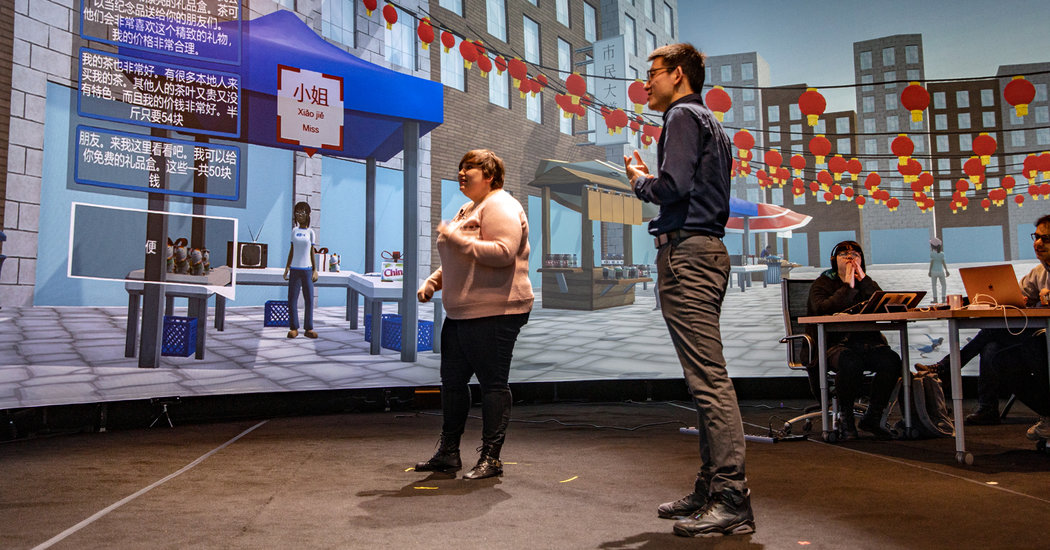This article is part of our latest Learning special report. We’re focusing on Generation Z, which is facing challenges from changing curriculums and new technology to financial aid gaps and homelessness.
MANCHESTER, N.H. — Cruising to class in her driverless car, a student crams from notes projected on the inside of the windshield while she gestures with her hands to shape a 3-D holographic model of her architecture project.
It looks like science fiction, an impression reinforced by the fact that it is being demonstrated in virtual reality in an ultramodern space with overstuffed pillows for seats. But this scenario is based on technology already in development.
The setting is the Sandbox ColLABorative, the innovation arm of Southern New Hampshire University, on the fifth floor of a downtown building with panoramic views of the sprawling red brick mills that date from this city’s 19th-century industrial heyday.
It is one of a small but growing number of places where experts are testing new ideas that will shape the future of a college education, using everything from blockchain networks to computer simulations to artificial intelligence, or A.I.
Theirs is not a future of falling enrollment, financial challenges and closing campuses. It’s a brighter world in which students subscribe to rather than enroll in college, learn languages in virtual reality foreign streetscapes with avatars for conversation partners, have their questions answered day or night by A.I. teaching assistants and control their own digital transcripts that record every life achievement.
The possibilities for advances such as these are vast. The structure of higher education as it is still largely practiced in America is as old as those Manchester mills, based on a calendar that dates from a time when students had to go home to help with the harvest, and divided into academic disciplines on physical campuses for 18- to 24-year-olds.
Universities may be at the cutting edge of research into almost every other field, said Gordon Jones, founding dean of the Boise State University College of Innovation and Design. But when it comes to reconsidering the structure of their own, he said, “they’ve been very risk-averse.”
Now, however, squeezed by the demands of employers and students — especially the up and coming Generation Z — and the need to attract new customers, some schools, such as Boise State and Southern New Hampshire University, are starting labs to come up with improvements to help people learn more effectively, match their skills with jobs and lower their costs.
College by Subscription
One of these would transform the way students pay for higher education. Instead of enrolling, for example, they might subscribe to college; for a monthly fee, they could take whatever courses they want, when they want, with long-term access to advising and career help.
The Georgia Institute of Technology is one of the places mulling a subscription model, said Richard DeMillo, director of its Center for 21st Century Universities. It would include access to a worldwide network of mentors and advisers and “whatever someone needs to do to improve their professional situation or acquire a new skill or get feedback on how things are going.”
Boise State is already piloting this concept. Its Passport to Education costs $425 a month for six credit hours or $525 for nine in either of two online bachelor’s degree programs. That’s 30 percent cheaper than the in-state, in-person tuition.
Paying by the month encourages students to move faster through their educations, and most are projected to graduate in 18 months, Mr. Jones said. The subscription model has attracted 47 students so far, he said, with another 94 in the application process.
However they pay for it, future students could find other drastic changes in the way their educations are delivered.
Your Teacher Is a Robot
S.N.H.U., in a collaboration with the education company Pearson, is testing A.I. grading. Barnes & Noble Education already has an A.I. writing tool called bartleby write, named for the clerk in the Herman Melville short story, that corrects grammar, punctuation and spelling, searches for plagiarism and helps create citations.
At Arizona State University, A.I. is being used to watch for signs that A.S.U. Online students might be struggling, and to alert their academic advisers.
“If we could catch early signals, we could go to them much earlier and say, ‘Hey you’re still in the window’ ” to pass, said Donna Kidwell, chief technology officer of the university’s digital teaching and learning lab, EdPlus.
Another harbinger of things to come sits on a hillside near the Hudson River in upstate New York, where an immersion lab with 15-foot walls and a 360-degree projection system transports Rensselaer Polytechnic Institute language students to China, virtually.
The students learn Mandarin Chinese by conversing with A.I. avatars that can recognize not only what they say but their gestures and expressions, all against a computer-generated backdrop of Chinese street markets, restaurants and other scenes.
Julian Wong, a mechanical engineering major in the first group of students to go through the program, “thought it would be cheesy.” In fact, he said, “It’s definitely more engaging, because you’re actively involved with what’s going on.”
Students in the immersion lab mastered Mandarin about twice as fast as their counterparts in conventional classrooms, said Shirley Ann Jackson, the president of Rensselaer.
Dr. Jackson, a physicist, was not surprised. The students enrolling in college now “grew up in a digital environment,” she said. “Why not use that to actually engage them?”
Slightly less sophisticated simulations are being used in schools of education, where trainee teachers practice coping with simulated schoolchildren. Engineering students at the University of Michigan use an augmented-reality track to test autonomous vehicles in simulated traffic.
A Transcript for Life
The way these kinds of learning get documented is also about to change. A race is underway to create a lifelong transcript.
Most academic transcripts omit work or military histories, internships, apprenticeships and other relevant experience. And course names such as Biology 301 or Business 102 reveal little about what students have actually learned.
“The learner, the learning provider and the employer all are speaking different languages that don’t interconnect,” said Michelle Weise, chief innovation officer at the Strada Institute for the Future of Work.
A proposed solution: the “interoperable learning record,” or I.L.R. (proof that, even in the future, higher education will be rife with acronyms and jargon).
The I.L.R. would list the specific skills that people have learned — customer service, say, or project management — as opposed to which courses they passed and majors they declared. And it would include other life experiences they accumulated.
This “digital trail” would remain in the learner’s control to share with prospective employers and make it easier for a student to transfer academic credits earned at one institution to another.
Unlike transcripts, I.L.R.s could work in two directions. Not only could prospective employees use them to look for jobs requiring the skills they have; employers could comb through them to find prospective hires with the skills they need.
“We’re trying to live inside this whole preindustrial design and figure out how we interface with technology to take it further,” said Ms. Kidwell of Arizona State. “Everybody is wrangling with trying to figure out which of these experiments are really going to work.”
This story was produced in collaboration with The Hechinger Report, a nonprofit, independent news organization focused on inequality and innovation in education.



















